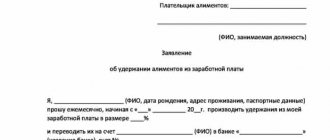This is important to know: Sample application for waiver of alimony to bailiffs
After checking the correctness of the specified information, the notary certifies the document, which can subsequently be used as an executive document.
The presence of grounds for making changes to the document or its termination requires that such actions be formalized in writing, with the participation of each of the parties, as well as mandatory notarization.
What is the basis for voluntary payment of alimony?
In the Russian Federation, there is a bailiff service that is supposed to protect the interests of minor dependents when receiving a child support obligation from a parent who is not caring for them. Therefore, the legislation of the Russian Federation provides for a procedure for paying alimony obligations in the event of unwillingness to fulfill the obligation, or in the presence of special circumstances that affect the deterioration of the financial situation of the alimony payer.
According to the current norms of the RF IC, a decision on financial support for children from a previous marriage can be made independently by both parties to the alimony burden.
By concluding a voluntary agreement with the alimony recipient, the alimony payer similarly strengthens the financial deduction procedure. The amount of payments of the alimony obligation is determined in court, in the event of controversial situations, however, after a court decision is made, the alimony payer can make payments without the participation of FSSP employees.
What is required to issue a court order?
That is, the procedure for certifying an agreement is possible only if two persons (parties to the agreement) appear before one notary at the same time.
This paper must record the time and place of preparation. The best option when transferring a receipt would be the presence of a third party who can confirm the fact of transfer of funds and receipt of the receipt.
Such a document can be drawn up by the child’s parents, regardless of whether they were previously married and lived together. If the child does not have natural parents, then the agreement can be drawn up by adoptive parents or guardians. To obtain alimony in court, you must submit an application to the magistrate's court for a court order to collect alimony.
No agreement
Voluntary payment of alimony without an agreement carries certain risks. Since the alimony recipient can take advantage of the fact that there is no documentary evidence of financial support from the alimony payer, and can apply to the court with a request to order the forced collection of alimony funds. In the event of initiation of legal proceedings for compulsory alimony payments, the alimony payer will re-pay the funds, provided that there is no documentary evidence of the transfers of funds made earlier. Therefore, voluntary payment of alimony without an agreement is possible only in the case of an extremely trusting relationship with the ex-spouse.
Additional questions
Number of alimony payments per month
As a rule, alimony is paid by a parent who does not live with the child at a given time, once a month in a certain amount of money, acting as a means of providing for and maintaining the child.
Important
By law, the payer can agree with the ex-spouse on the collection procedure and date.
I'm standing at the labor exchange. How to pay child support?
If a parent who is obliged to pay child support once a month is on the labor exchange, then this problem is solved as follows:
- An application is drawn up to the justice system in which the citizen asks to repay the existing debt;
- Funds are deducted from unemployment benefits for alimony.
In modern times, you can even pay child support from home. To do this, use Sberbank Online. It is important to understand and take into account that legislation is constantly changing. In addition, the courts take into account not only the pay of the paying parent, but also other details, so the final amount of payments may differ from the initial one.
At what point does the payment start?
The parent who is required to pay child support begins to do so immediately after a notarial agreement is concluded or a statement of claim is filed.
This is also important to know:
Deprivation of rights for alimony
If there is voluntary consent, the start date of payments is discussed by the parents and set independently.
If a parent has applied to the court with a request to collect child support, then after the court decision is announced, the funds must be transferred starting from the month when the claim was filed.
If the alimony payer persistently does not pay alimony, the second parent has every right to go to court with a request to recover funds for the entire period when they were not paid. In order to do this, you need to provide evidence of the absence of alimony payments.
Important
The limitation period is not taken into account in this case. The parent can apply to the judicial authorities at any time and collect the amount of debt from the payer until the child reaches adulthood.
Receipt
Documentation that can confirm the procedure for the alimony payer to provide financial support may be:
- receipts confirming the purchase of clothing, toys, food, etc.
- receipts for the transfer of financial assistance from the alimony payer’s account to the alimony recipient’s account.
As a rule, the alimony payer transfers financial assistance in the form of cash to the recipient, therefore, in the absence of a receipt for receipt of these funds, it will be impossible to prove the fact of transfer.
When transferring financial assistance, it is necessary to draw up a receipt with the personal signature of the alimony recipient, so that when initiating legal proceedings, the alimony payer can prove the fact of the transfer of funds. If the alimony recipient clearly does not want to draw up a receipt for receipt of funds, it is necessary to contact the court to draw up an agreement on the procedure and amount of alimony payments.
With agreement
Concluding a voluntary settlement agreement on the payment of alimony obligations is the most convenient, profitable, and eliminates all kinds of unforeseen risks associated with the transfer of funds. To receive voluntary child support with the conclusion of an agreement, you must:
- draw up a free-form text of the agreement;
- contact a notary;
- discuss the list of items that will be included in the text of the agreement;
- come to mutual agreement and notarize the text of the agreement.
Important
The list of clauses and provisions of the agreement must be approved by both parties to the alimony obligation, and must not contradict the current legislation of the Russian Federation.
Former spouses in the process of divorce, with a common minor child, entered into a voluntary agreement on the monthly transfer of alimony obligations in the amount of 15,000 rubles. After the procedure of notarization of the text of a voluntary agreement, it is impossible to make changes to the amount and procedure of payments without the consent of the 2nd party. If the text contains provisions that violate the rights of one of the parties to the alimony obligation, or one of the parties does not comply with the procedure for paying funds, then either party has the right to apply to the court with a petition to amend the text of the agreement unilaterally, or about the cancellation of this agreement.
The amount of content established by agreement
A document that indicates the existence of agreements between parents should not infringe on the rights of children that are granted to them by the state. In this connection, the amount of payments for one child cannot be less than a quarter of the total income of the payer; for two, the payment will be at least a third of the funds received; three or more will receive half.
In the event of a significant change in the property or marital status of the payer, appropriate amendments may be made to the agreement, or the recipient may be given the right to seek judicial protection and establish alimony by a court decision.
Example of voluntary payment
Example. The ex-wife, citizen Ivanova E.I., initiated legal proceedings to recover alimony payments in the amount of 25% of all types of earnings of the ex-husband Ivanov K.S. Citizen Ivanov K.S. provided the court with documents confirming his status as an unemployed person, who is listed on the labor exchange and receives a social benefit in the amount of 5,000 rubles. When calculating the amount of alimony obligation in the amount of 25% of earnings, in this case, the amount of payments was less than 2,000 rubles. Since the person liable for alimony has another, unofficial source of income, which he receives in the case of providing construction services, without drawing up an agreement. This type of income is irregular, so the alimony recipient agreed with his ex-wife on the voluntary payment of alimony in the amount of 5,000 rubles, which he will pay against receipt, and the alimony recipient, in turn, will not submit enforcement proceedings to the FSSP service.
This is also important to know:
Statement of claim for cancellation of alimony: valid reasons and sample application
In this example, the alimony payer conscientiously fulfills his obligations to support a minor dependent, transferring financial assistance in his favor that exceeds the amount that the dependent would have received under the legislation of the Russian Federation. At the same time, the ex-wife cannot make claims against citizen K.S. Ivanov for evading the payment of alimony obligations, since he transfers funds by receipt.
Who has the right to draw up an agreement
Who has the right to take receipts and draw up agreements? The following categories of citizens have the right to draw up the text of a settlement agreement for the payment of alimony obligations necessary for the maintenance of a child:
- parents/adoptive parents of a minor dependent;
- guardians;
- minor dependents, upon reaching the age of 14, with the consent of their legal representatives.
Methods of voluntary payment of alimony
Free legal consultation We will answer your question in 5 minutes!
Ask a Question
Voluntary payment of funds for alimony obligations can be made in the following ways:
Free legal consultation
We will answer your question in 5 minutes!
Ask a Question
- transfer by the alimony payer of funds to the alimony recipient personally;
- calculation of alimony payments by the accounting department of the organization in which the alimony payer works; by postal transfer;
- by transferring funds to the bank details of the alimony recipient.
In order to confirm the fact of payment of alimony funds, it is necessary to save documentation (checks, receipts, receipts, bank statements, etc.)
Voluntary fulfillment of alimony obligations under an existing court decision
Official confirmation of obligations to pay alimony can be achieved on the basis of an agreement, a court decision or a court order.
The issuance of a court order is carried out in a simplified manner, based on the plaintiff’s application to the magistrate’s court, without summoning the parties. A court decision to collect alimony is made in the general manner after an adversarial process, during which each party has the right to present evidence, express their own opinion, etc.
The received writ of execution or court order cannot become an obstacle to the voluntary fulfillment of obligations on the part of the defendant. Each such payment must be confirmed by a receipt.
Procedure
Let's look at how to voluntarily pay alimony:
- In the process of drawing up the text of the agreement, it is necessary to mutually discuss the issues and clauses that will be spelled out in the agreement, indicating all the circumstances; it is worth noting that both the alimony payer and the alimony recipient may have individual requirements that can replace or exclude each other. In such a case, the parties will have to compromise.
- Draw up the text of the agreement.
- Contact a notary office.
- Verify the text of the agreement.
- Wait until the document comes into force (if there is no deadline specified in the document).
- Conscientiously fulfill the conditions and requirements according to the text of the voluntary agreement.
Payment options
In order not to transfer money again in the future, it is worth thinking about how to correctly pay alimony voluntarily. The legislation of the Russian Federation provides for the following options for payment of alimony funds:
- A fixed amount of money. Both parents agree to accrue alimony in the form of a fixed amount of money, regardless of the earnings of the alimony payer.
- The percentage of income that will be contributed by the employer of the alimony payer at the place of employment. This percentage will be calculated in accordance with the number of dependents who are supported by the alimony obligee (from 25% to 50% of the total source of income).
- Synthesis of the options proposed above. This method is used in cases where the alimony payer’s earnings are uneven and irregular, as well as if the payer provides an official document indicating the presence of income that is insufficient to deduct interest on alimony support, which cannot satisfy the natural needs and needs of a minor dependent.
Regardless of the choice of method of voluntary payment of alimony obligations, it is necessary to remember the possible need to index the amount of money depending on the state of the economy in the country.
How is alimony calculated?
According to the RF IC, funds can be calculated in a fixed sum of money or as a percentage of the payer’s income (Article 81.83 of the RF IC).
Deductions as a percentage of salary
When deducting as a percentage, those types of income are taken into account that contribute to increasing the payer’s well-being and improving his quality of life. Such income includes bonuses, additional payments for overtime work, allowances, income from the rental of real estate or the turnover of securities and others provided for by Decree of the Government of the Russian Federation No. 841 of July 18, 1996. When calculating alimony, payments that have social benefits are not included in the total income focus, for example, on burial, on urgent surgery, on the needs of newborn children.
Read more: From what income is child support withheld, collected and not withheld?
The amount of payments is set at:
- for 1 child - 25%;
- for 2 children - 33%;
- by 3 or more - 50%.
The most common question is how to pay alimony to children from different marriages, because the amount of penalties in total will exceed the percentage of deductions established by law. In such cases, it is necessary to file a claim to reduce deductions due to new circumstances.
For example , citizen S. paid alimony to son A. in the amount of 25% of income, and to his daughter from his second marriage - 16% of income, since the court took into account that S. had a dependent. S. filed a lawsuit to reduce the amount of penalties on his son from ¼ to 1/6 of his income, and by court decision, the deductions were reduced.
The frequency of payments issued through the court is monthly, by agreement of the parties - as convenient for the payer and recipient.
Hard cash deductions
The method of paying alimony in a fixed amount is provided for in Art. 83 RF IC. Their size is set at an amount at which the child’s standard of living will be no worse than before. Fixed payments are convenient in the following cases:
- if the payer’s income is unstable;
- the payer is not officially employed, is employed part-time, has third-party sources of income;
- the salary comes in foreign currency or in kind;
- the payer is an individual entrepreneur.
To cover the needs of the recipient, a mixed payment system can be used: partly in a flat amount, partly in a percentage.
For the purpose of indexing alimony, its size is tied to the subsistence minimum (ML) in the region of residence. For example, penalties may be equal to 0.6 PM, 1.5 PM, 3 PM or another value.
Transfer methods
When making voluntary payment of alimony obligations, it is worth clarifying the method of performing the financial support procedure. There are several types for transferring/transferring financial assistance. An important point is to choose a method that will satisfy the interests of both parents:
- cash transfer;
- providing non-cash assistance (transfer of natural products, purchase of seasonal clothing, etc.)
This is also important to know:
Administrative liability for non-payment of alimony: when and for what reason does it occur
Example. The alimony payer does not carry out official labor activities and does not have a permanent income. He is an informal farmer. In this case, he cannot transfer any amount of alimony funds, but can provide financial assistance in the form of donating food products.
Amount and form of payments
Guided by the provisions of the RF IC, it is necessary to remember that the amount of alimony collection carried out in accordance with the adopted voluntary agreement cannot be less than the amount provided for by law. But both parties to the alimony obligation have the right to independently determine the amount of payments transferred.
In accordance with the legislation of the Russian Federation, the size and procedure of the alimony obligation, if the alimony payer has official income, depends on the number of minor children dependent on him:
- 25% - will be withheld for the maintenance of 1 child;
- 33% - for the maintenance of 2 children;
- 50% will be withheld to support 3 or more minor dependents.
Guided by the provisions of Art. 90 of the RF IC, a spouse/ex-wife may claim alimony in the following cases:
- if she is carrying a common child;
- if she is on maternity leave for a child under 3 years old;
- etc. grounds.
When assigning an alimony obligation in a fixed amount, it is necessary to take into account the regional cost of living.
Required documents
To conclude a voluntary agreement by contacting a notary office, there is no need to provide documents confirming the level of financial situation of the parties. The list of required papers is presented by the following documents:
- passport details of both parties;
- certificate of marriage/divorce;
- birth certificate of the child/children.
It is necessary to first clarify the list of documents required by the notary to certify the agreement, which he can request at any time during the preparation of the agreement.
The procedure for obtaining alimony without court
Calculation of alimony in a shared ratio is used, as a rule, when the payer has a regular income. Its size will be standard: for one child - a quarter, for two - a third, and for three or more - half of the income.
When drawing up an agreement, you should be guided by the example image below. There are a few key things to consider that could have a serious impact on future payments.
The parties agreed that alimony would be paid once a month in the amount of 10 thousand rubles. An agreement was drawn up regarding this. From the moment it is signed and certified, even if one of the parties decides that the amount is too large/small, it will not be possible to make changes in any way except with the consent of the other party.
You also need to have the following documents with you:
- Passports;
- Metrics for children to whom child support will be paid;
- Certificate of marriage or divorce;
- Certificate of income from the place of work.
In most cases, parents fulfill child support obligations voluntarily. Appeal to the court occurs when the alimony payer evades his duties.
One of your arguments, in particular, may be to transfer money to her card (take a bank statement). Testify that you partially paid alimony in this way.
This is important to know: What percentage of the salary goes to child support for parents?
Why at your own peril and risk? The fact is that the second party, despite regularly transferring money, can take advantage of the fact that there is no official court order or agreement.
One of your arguments, in particular, may be to transfer money to her card (take a bank statement). Testify that you partially paid alimony in this way.
Of course, this is only true if the payer cannot prove that he paid the money before.
In most cases, parents fulfill child support obligations voluntarily. Appeal to the court occurs when the alimony payer evades his duties.
Expenses
The service provided by a notary, when certifying a voluntary agreement, will cost the parties from 3,000 rubles. up to 5,000 rubles, depending on regional pricing policy. It does not matter whether the notary assisted in drawing up a notarial agreement or simply certified the text of the document, the service will be paid in full. Before contacting a notary office, you must familiarize yourself with the price list of notary services in a particular region. As a rule, notary offices and specialists who do not require a large fee will be the priority choice.
Amendments to or withdrawal from the agreement
Each participant in the alimony obligation fulfilled through the conclusion of an agreement has the right to make adjustments to its text, subject to the consent of the other party. It is possible to make changes unilaterally in the following cases:
- violation of compliance with the points provided for in the agreement;
- clauses of the document infringe on the rights of any party.
In the first case, the party must file a petition with the court to amend the text of the agreement or to cancel it.
Application for voluntary payment (sample)
The law does not provide for an approved form for filing an application for voluntary payment of alimony obligations. The alimony payer cannot apply unilaterally to formalize a voluntary agreement, since the need for such a document arises when the alimony recipient revokes the writ of execution. The reason for the revocation may be the agreement of the former spouses on the voluntary transfer of financial support by the alimony payer, the amount of which differs from the imposed penalty under enforcement proceedings or other notarial document.
To receive alimony voluntarily upon application, you must:
- fill out an application addressed to the head of the FSSP;
- contact the FSSP at the place where the enforcement proceedings were filed.
To complete the document correctly, you must provide the following information:
- name and address of the FSSP;
- passport details of the alimony recipient;
- address of the actual residence;
- information about enforcement proceedings or notarial agreement;
- indication of the reason for the withdrawal of the writ of execution;
- application for return;
- day month Year;
- personal signature.
This is also important to know:
Statement of claim to establish paternity and collect alimony: sample document, filling it out and submitting it
The application header must include the following information:
- to the head of the FSPP;
- organization address;
- last name, first name, patronymic of the alimony recipient;
- address of the actual residence;
- Full name of the individual in whose interests the application is being submitted.
Title: “Application for termination of the writ of execution (notarial agreement) for the payment of alimony.”
The structure of the document is represented by 4 logical connected parts:
Part I. Indicates when (date), what document (number, date), on the basis of what decision (date number), the content of the court decision, in whose favor it was directed.
Part II. Execution of enforcement proceedings, alimony payer.
Part III. Reason for revocation of the writ of execution (agreement of the parties).
Part IV. Request for the return of the writ of execution.
Free legal consultation We will answer your question in 5 minutes!
Call: 8 800 511-39-66
Personal signature (with transcript), day, month, year.
Free legal consultation
We will answer your question in 5 minutes!
Ask a Question
The procedure for drawing up a document can cause certain difficulties, so it is necessary to contact a competent lawyer for advice.
Registration of a court order
To issue a court order to initiate the procedure for collecting alimony payments, you must submit a petition to the court/magistrate.
List of data that must be indicated in the application:
- name of the court;
- Full name and address of actual residence of the alimony recipient;
- Full name and address of actual residence of the alimony payer;
- requirements of the alimony recipient;
- documents confirming the actual income of the alimony payer, on the basis of which the alimony recipient’s application is initiated;
- list of documents provided;
- marriage certificate;
- birth certificate of common children/child;
- number of common children;
- personal data of children (full name, date of birth);
- FULL NAME. and information about the parent who provides direct care for the children and lives in the same living space with them.
Documents that must be attached to the application:
- copies of marriage and divorce certificates (if available);
- a copy of the certificate of paternity (in the absence of a marriage certificate);
- copies of birth certificates of children for whom child support will be collected;
- a copy of the agreement, certified by a notary, on the procedure for meetings and communication with children in the event of divorce proceedings (if any);
- an extract from the court order identifying the parent who is directly caring for the minor dependent(s) in the event of a divorce;
- certificate of residence with a minor dependent in the same living space (for the alimony payer);
- a certificate of income indicating the position at the place of work of the alimony payer.
The application must also note the lack of official employment of the alimony payer.
Important
The application and the list of attached documentation are provided to the magistrate or sent by registered mail.
When a court order is issued, the amount of alimony transfers will not differ from the amount of payments made through a voluntary agreement to fulfill the alimony encumbrance.
Registration of receipt
Legal force, in accordance with the current legislation of the Russian Federation, will be enjoyed by a receipt drawn up taking into account the following requirements:
- handwritten text written legibly, without erasures or corrections;
- indication of the time period and place of compilation;
- presence of a third party to confirm the fact of transfer of funds (desirable);
- information about the witness present when drawing up the document;
- passport details of both parties to the alimony obligation;
- the amount of alimony payments made, which is written in two ways (in numbers and in words, indicating the currency).
It is necessary to check the text of the receipt and the data specified in it, and then notarize the receipt. For a receipt to have legal force it is necessary:
- indicate the goals for which financial resources are required;
- time period of the next payment;
- recipient details.
Liability for non-payment
When concluding a voluntary agreement to fulfill the alimony obligation, the alimony payer may evade its fulfillment. In this case, the alimony recipient must take enforcement action to bring the alimony defaulter to justice. The legislation of the Russian Federation provides for the following types of liability applicable to a draft dodger:
- civil;
- administrative;
- criminal
When assigning civil liability to a non-payer of alimony, which can be imposed by court decision, standard penalties are applied in the amount of 0.5% for each day of delay in payment.
Assignment of administrative liability, to which an alimony defaulter can be brought by an employee of the FSSP, according to the current legislation, the following types of punishments are provided:
- arrest of the alimony payer for a period established by law;
- seizure of property for the purpose of sale to pay off alimony debt;
- deprivation of driver's license;
- ban on crossing the border;
- other.
Important
The most serious measure of liability is deprivation of parental rights. This measure can only be applied if legal proceedings are initiated. If the petition for deprivation of parental rights is granted, then the obligation to fulfill the alimony obligation will remain with the alimony payer.
Criminal liability provides for the following types of punishment:
- assignment of forced labor;
- imprisonment (1 year).
This is also important to know:
Application for a court order for alimony: sample document and procedure for obtaining it
Imprisonment, as a punishment due to arrears in alimony payments, is rarely used in practice, since in the case of imprisonment, the alimony payer will not be able to repay the debt, and will only increase its size, which means child support will never be paid.
Additional questions
How to properly pay alimony payments through Sberbank
Currently, a common method of paying alimony transfers in the Russian Federation is a transfer through the services of Sberbank. There are several types of transfers of financial resources that are used when alimony is paid voluntarily:
- to the alimony recipient's card using the terminal;
- by contacting the branch cash desk;
- using an Internet resource in the Sberbank Online system;
- non-cash payment to the bank account of the alimony recipient.
When fulfilling an alimony obligation through a bank transfer, you can simplify the task by contacting the accounting department at the place of employment of the alimony payer, providing the text of the agreement/court decision, which will indicate the terms and amount of alimony payments. When carrying out such procedures, payments will be made automatically by accounting staff.
If the transfer of alimony payments is made using Sberbank: through a cash register, through an Internet resource or terminal, then you must indicate the name of the alimony and the paid time period.
When transferring alimony funds to a card or account of other banks, the commission will be from 1 to 1.5% of the transfer amount.
Apartment as alimony payment
The legislation of the Russian Federation does not prohibit the fulfillment of alimony obligations by transferring a large lump sum payment or donating property.
As a rule, the transfer of property is forced, as a punishment. Thus, FSSP employees seize the living space and then sell it to eliminate arrears of alimony payments. You can also pay alimony voluntarily by transferring the ownership of the living space to the child.
Types of real estate that can be transferred voluntarily:
- Living space purchased by the alimony payer before marriage.
- Housing that was donated to the alimony payer.
- Share in residential premises.
- Housing received by the alimony payer as a result of inheritance.
Thus, any property that is owned by the alimony payer can be transferred to a minor. In this case, property that has an encumbrance (mortgage, arrest) cannot be transferred to the dependent.
Important
To carry out the procedure for transferring property for alimony payments, both parties to the alimony encumbrance must draw up a written agreement and have it certified by a notary.
This agreement must include the following information:
- Time and place of signing.
- Parents of a minor child.
- A minor child.
- Description of the subject of the agreement.
- The cost of the transferred living space.
- Duration of the contract.
- Responsibilities of the parties.
- Personal signatures.
It is also necessary to sign additional documents, such as an act of acceptance and transfer of living space. After this procedure, the property must be registered in the name of the minor dependent.
Conclusion
Voluntary payment of child support is the responsibility of every parent who is not directly caring for minor children. In order to prevent unpleasant situations associated with the voluntary payment of funds, it is necessary to draw up receipts for the transfer. Otherwise, the alimony recipient may apply to the court to order forced payments of the alimony obligation, since there is no documentary evidence of the transfer of financial resources. If alimony encumbrance is assigned to the alimony payer through court proceedings, then the procedure for paying alimony funds must be carried out in the manner and amount approved by the court.
Subscribe to the latest news
How to pay child support?
You need to help the child regardless of whether there is a writ of execution or whether the spouse has applied for alimony.
If the father (mother) voluntarily transfers money to the child, it is necessary to indicate that this is “Alimony”. If the relationship worsens, the recipient can claim funds for the children for the past period equal to the previous three years. It will be extremely difficult to prove that the child received help.
How alimony is paid after trial: procedure
The trial took place, the court made a positive decision on the payment of alimony, what next? The court decision is executed immediately (Article 211 of the RF IC). The procedure will then consist of several steps:
- The claimant's appeal to the secretary with an application for the issuance of a writ of execution (IL). The court can send the IL to the FSSP at the request of the applicant, but it is recommended to monitor the process.
- Filing an application to initiate enforcement proceedings. It will take no more than 3 days to issue the relevant resolution.
- Taking measures to collect alimony. The bailiff, responsible for the timeliness and correctness of collections, talks with the alimony provider. The payer may agree to hand over the money in person on certain dates. One of the reliable options to ensure timely payments is to send the IL to the enterprise where the payer works. Then the accounting department will handle the deductions. The recipient or the payer can submit the IL to the employer in person.
Often the writ of execution “gathers dust” in a secluded corner of the claimant, and the payer is tormented by the question: is it necessary to pay alimony if the bailiffs do not have the writ of execution? The answer is that you must pay immediately, otherwise a significant amount will be claimed later for the entire missed period.









